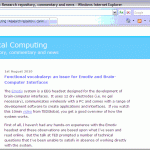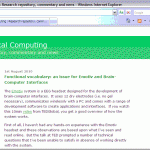I recorded my heart rate using the body blogging system and my daily mood using Moodscope for three months in 2011. I wrote about the aim of this project and some intermediary experiences in previous blogs and would now like to talk about my final impressions and what I learned from combining the two systems. I presented these results at the Quantified Self Conference in Amsterdam in November 2011.
Continue reading
Tag Archives: mood
Mood and Music: effects of music on driver anger
Last month I gave a presentation at the Annual Meeting of the Human Factors and Ergonomics Society held at Leeds University in the UK. I stood on the podium and presented the work, but really the people who deserve most of the credit are Marjolein van der Zwaag (from Philips Research Laboratories) and my own PhD student at LJMU Elena Spiridon.
You can watch a podcast of the talk above. This work was originally conducted as part of the REFLECT project at the end of 2010. This work was inspired by earlier research on affective computing where the system makes an adaptation to alleviate a negative mood state. The rationale here is that any such adaptation will have beneficial effects – in terms of reducing duration/intensity of negative mood, and in doing so, will mitigate any undesirable effects on behaviour or the health of the person.
Our study was concerned with the level of anger a person might experience on the road. We know that anger causes ‘load’ on the cardiovascular system as well as undesirable behaviours associated with aggressive driver. In our study, we subjected participants to a simulated driving task that was designed to make them angry – this is a protocol that we have developed at LJMU. Marjolein was interested in the effects of different types of music on the cardiovascular system while the person is experiencing a negative mood state; for our study, she created four categories of music that varied in terms of high/low activation and positive/negative valence.
The study does not represent an investigation into a physiological computing system per se, but is rather a validation study to explore whether an adaptation, such as selecting a certain type of music when a person is angry, can have beneficial effects. We’re working on a journal paper version at the moment.
REFLECT Project Promo Video
Some months ago, I wrote this post about the REFLECT project that we participated in for the last three years. In short, the REFLECT project was concerned with research and development of three different kinds of biocybernetic loops: (1) detection of emotion, (2) diagnosis of mental workload, and (3) assessment of physical comfort. Psychophysiological measures were used to assess (1) and (2) whilst physical movement (fidgeting) in a seated position was used for the latter. And this was integrated into the ‘cockpit’ of a Ferrari.
The idea behind the emotional loop was to have the music change in response to emotion (to alleviate negative mood states). The cognitive loop would block incoming calls if the driver was in a state of high mental workload and air-filled bladders in the seat would adjust to promote physical comfort. You can read all about the project here. Above you’ll find a promotional video that I’ve only just discovered – the reason for my delayed response in posting this is probably vanity, the filming was over before I got to the Ferrari site in Maranello. The upside of my absence is that you can watch the much more articulate and handsome Dick de Waard explain about the cognitive loop in the film, which was our main involvement in the project.
Moodscope, subjective ratings and body blogging: my first impressions
At the beginning of the year I proposed to track my mood via Moodscope (subjective measure) while body blogging (physiological measure), what follows is my initial impressions so far in using these technologies before presenting my conclusions at the Quantified Self Conference in Amsterdam in November.
Moodscope, subjective ratings and body blogging
Admin: Please welcome to the site our new Physiological Computing blogger.
My name is Ute Kreplin and I am a new PhD student at Liverpool John Moores University under the supervision of Dr Steven Fairclough. My PhD research topic is on Neuroaesthetics with a focus on “interest” in the aesthetic experience and its psychophysiological underpinnings. I am also very interested in positive psychology, which I am pursuing through studies at the University of East London. I am combining my interest in positive psychology and physiological computing in this blog, which will hopefully be my first of many.
Continue reading
The Moody Web
We’re sporting a new look this month here at Physiological Computing, several in fact, as we’ve turned the web interface into an online mood ring. Using the online heartbeat rate of our body blogger (read more here on the BodyBlogger) the colour scheme of the site is set according to the users current physiological state.
Currently 4 colour schemes are supported: –
Each scheme is mapped onto a different physiological range which are as follows: –
- Relaxed: less than 60 beats per minute (bpm)
- Normal: 60 to 80 bpm
- Elevated: 80 to 100 bpm
- Burning: More than 100 bpm
These ranges and their implied state have been configured for our current body blogger who transitions through them on a daily basis (e.g. burning – running).
I’ll be updating more about the Moody Web later on this week, for the time being enjoy our take on adding a touch of the personal to the web.




